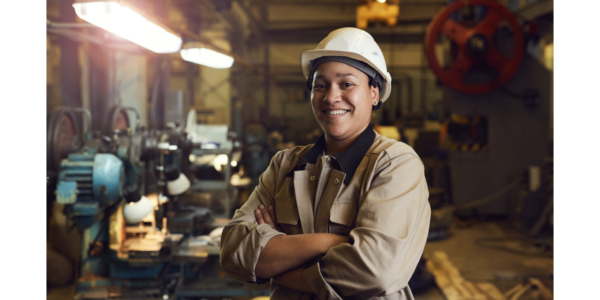PPE, or personal protective equipment, is a must in most of the environments where you find Indramat machinery: factories, warehouses, printing press facilities, and the like. Hard hats, safety boots, ear protection, safety glasses, gloves, respirators, protective vests — all the gear that protects workers from hazards in the workplace. How well this equipment works depends to a large extent on how well it fits. And that’s where PPE for women runs into trouble.
A survey of 2,635 women and non-binary individuals found that just 19% of them reported having consistent access to PPE that fit correctly. And yet there are companies that make PPE specifically for women. What’s the problem?
Lack of gender-specific PPE
There are options made for women on the market, but most PPE is designed for a “standard” male body, which often doesn’t fit women’s proportions. Gloves that are too big, harnesses that don’t adjust properly, boots that pinch or slip, and respirators that leak around the face can actually be more dangerous than going without PPE.
In addition, ill-fitting PPE can be uncomfortable and impede mobility, reducing productivity and focus.
Limited selection of women’s PPE
Even when women-specific options exist, they may be more expensive. Cost can be a barrier, especially for smaller companies or individual workers. When their workforce is primarily men, a company might keep only one or two items for women on hand. They might wait until they hire more women to invest in appropriate PPE, figuring that one or two female workers can make do until they’re ready to make the purchase.
What’s more, since availability and awareness are limited, the options may not be as good as they should be. The “Shrink it and pink it” approach involves rebranding existing men’s PPE as “women’s” without addressing fit issues. A safety vest in a smaller size and a pink color sure looks like it’s made for women, but if the proportions are not changed from the men’s size, it probably won’t fit.
Even women’s feet generally have different proportions from men’s feet. For larger companies, there may also be cases in which you will need PPE for pregnant women. Women may also avoid raising concerns about ill-fitting PPE due to fear of being seen as complaining or not tough enough. Purchases of women’s PPE should involve women in the decision making process.
Why it matters
Women face higher risks of musculoskeletal disorders, heat stress, and exposure to hazardous materials if they have to cope with ill-fitting PPE. That should be enough of a reason to amen the effort to provide suitable PPE for women.
However, they may also face reduced productivity and job satisfaction, or even a feeling of exclusion and being undervalued in the workplace.
Taking the time and making the effort to acquire well-fitting PPE for women can not only increase the safety and satisfaction of female workers in your facility, but may also make it easier to attract and keep women in new positions. Encouraging open communication and feedback on PPE issues, involving women in the decision-making, and making a commitment to inclusivity can help ensure that all workers, regardless of gender, have access to safe and effective PPE that protects their health and well-being.
